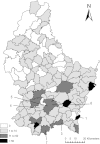Characterization of newcastle disease viruses in wild and domestic birds in Luxembourg from 2006 to 2008
- PMID: 23160119
- PMCID: PMC3553785
- DOI: 10.1128/AEM.02437-12
Characterization of newcastle disease viruses in wild and domestic birds in Luxembourg from 2006 to 2008
Abstract
Newcastle disease virus (NDV) is one of the most important viral diseases of birds. Wild birds constitute a natural reservoir of low-virulence viruses, while poultry are the main reservoir of virulent strains. Exchange of virus between these reservoirs represents a risk for both bird populations. Samples from wild and domestic birds collected between 2006 and 2010 in Luxembourg were analyzed for NDV. Three similar avirulent genotype I strains were found in ducks during consecutive years, suggesting that the virus may have survived and spread locally. However, separate introductions cannot be excluded, because no recent complete F gene sequences of genotype I from other European countries are available. Detection of vaccine-like strains in wild waterbirds suggested the spread of vaccine strains, despite the nonvaccination policy in Luxembourg. Among domestic birds, only one chicken was positive for a genotype II strain differing from the LaSota vaccine and exhibiting a so-far-unrecognized fusion protein cleavage site of predicted low virulence. Three genotype VI strains from pigeons were the only virulent strains found. The circulation of NDV in wild and free-ranging domestic birds warrants continuous surveillance because of increased concern that low-virulence wild-bird viruses could become more virulent in domestic populations.
Figures



References
-
- OIE 2012. Chapter 2.3.14. Newcastle disease. In OIE (ed), Manual of diagnostic tests and vaccines for terrestrial animals, 7th ed OIE Organisation Mondiale de la Santé Animale, Paris, France: http://www.oie.int/fileadmin/Home/eng/Health_standards/tahm/2.03.14_NEWC...
-
- Collins MS, Strong I, Alexander DJ. 1994. Evaluation of the molecular basis of pathogenicity of the variant Newcastle disease viruses termed “pigeon PMV-1 viruses.” Arch. Virol. 134:403–411 - PubMed
-
- Takakuwa H, Ito T, Takada A, Okazaki K, Kida H. 1998. Potentially virulent Newcastle disease viruses are maintained in migratory waterfowl populations. Jpn. J. Vet. Res. 45:207–215 - PubMed
-
- Diel DG, da Silva LH, Liu H, Wang Z, Miller PJ, Afonso CL. 2012. Genetic diversity of avian paramyxovirus type 1: proposal for a unified nomenclature and classification system of Newcastle disease virus genotypes. Infect. Genet. Evol. 12:1770–1779 - PubMed
-
- Aldous EW, Mynn JK, Banks J, Alexander DJ. 2003. A molecular epidemiological study of avian paramyxovirus type 1 (Newcastle disease virus) isolates by phylogenetic analysis of a partial nucleotide sequence of the fusion protein gene. Avian Pathol. 32:239–256 - PubMed
Publication types
MeSH terms
Substances
Associated data
- Actions
- Actions
- Actions
- Actions
- Actions
- Actions
- Actions
- Actions
- Actions
LinkOut - more resources
Full Text Sources

